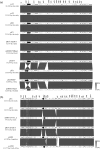Acquisition of mcr-1 and Cocarriage of Virulence Genes in Avian Pathogenic Escherichia coli Isolates from Municipal Wastewater Influents in Japan
- PMID: 31492666
- PMCID: PMC6821974
- DOI: 10.1128/AEM.01661-19
Acquisition of mcr-1 and Cocarriage of Virulence Genes in Avian Pathogenic Escherichia coli Isolates from Municipal Wastewater Influents in Japan
Abstract
This study focused on the detection of the plasmid-mediated mcr colistin resistance gene in Escherichia coli isolates from wastewater treatment plants (WWTPs). Seven influent samples were collected from three WWTPs in Nagano Prefecture, Japan, during August and December 2018. Colistin-resistant E. coli isolates were selected on colistin-supplemented CHROMagar ECC plates. mcr-1-positive isolates were subjected to whole-genome sequencing (WGS) analysis. From six influent samples, seven mcr-1-positive but extended-spectrum β-lactamase (ESBL)-negative isolates belonging to different genetic lineages, namely, B2-O25:H4-ST131-fimH22, B2-O2:H1-ST135-fimH2, B1-O8:H9-ST764-fimH32, B1-O23:H16-ST453-fimH31, A-O81:H27-ST10-fimH54, A-O16:H5-ST871-fimH25, and F-O11:H6-ST457-fimH145, were detected. The MICs of colistin for these isolates ranged from 4 to 16 mg/liter. The mcr-1 genes were located on plasmids belonging to IncX4 and IncI2 in five and two isolates, respectively. Four IncX4 plasmids with the same size (33,309 bp) showed high sequence similarity (4 single-nucleotide variations). The remaining one IncX4 plasmid, with a size of 33,858 bp, carried the mcr-1 gene with the single synonymous nucleic substitution T27C. Two IncI2 plasmids with sizes of 60,710 bp and 60,733 bp had high sequence similarity (99.9% identity; 100% query coverage). Two of five isolates carrying IncX4 plasmids and both of the isolates carrying IncI2 plasmids harbored ColV plasmids carrying virulence-associated genes of avian pathogenic E. coli (APEC). In addition, another isolate of the B2-O25:H4-ST131-fimH22 lineage had those APEC-associated virulence genes on its chromosome. In conclusion, mcr-1-positive E. coli environmental isolates were mostly characterized as positive for APEC-associated virulence genes. The copresence of those genes may suggest the existence of a common source in animals and/or their associated environments.IMPORTANCE Colistin is considered a last-line therapeutic option in severe infections due to multidrug-resistant Gram-negative bacteria, in particular carbapenemase-producing Enterobacteriaceae and multidrug-resistant Acinetobacter baumannii An increasing prevalence of mcr genes in diverse Enterobacteriaceae species, mainly Escherichia coli and Klebsiella pneumoniae from humans and food animals, has become a significant concern to public health all over the world. In Japan, mcr genes have so far been detected in food animals, raw meat, wastewater, and human clinical samples. This study reports the copresence of mcr-1 and avian pathogenic E. coli (APEC)-associated virulence genes in five of seven E. coli isolates recovered from aquatic environments in Japan. Our study highlights the importance and urgency of action to reduce environmental contamination by mcr genes that may likely occur due to exposure to untreated wastewater through combined sewer overflow by recent unusual weather.
Keywords: APEC; ColV; WWTPs; mcr-1.
Copyright © 2019 American Society for Microbiology.
Figures


Similar articles
-
Complete Genetic Analysis of Plasmids Carrying mcr-1 and Other Resistance Genes in Avian Pathogenic Escherichia coli Isolates from Diseased Chickens in Anhui Province in China.mSphere. 2021 Apr 14;6(2):e01135-20. doi: 10.1128/mSphere.01135-20. mSphere. 2021. PMID: 33853876 Free PMC article.
-
Wastewater as a Probable Environmental Reservoir of Extended-Spectrum-β-Lactamase Genes: Detection of Chimeric β-Lactamases CTX-M-64 and CTX-M-123.Appl Environ Microbiol. 2019 Oct 30;85(22):e01740-19. doi: 10.1128/AEM.01740-19. Print 2019 Nov 15. Appl Environ Microbiol. 2019. PMID: 31519655 Free PMC article.
-
First detection of VEB-1 extended-spectrum β-lactamase-producing Escherichia coli clinical isolate in Japan.Microbiol Spectr. 2024 Nov 5;12(11):e0052324. doi: 10.1128/spectrum.00523-24. Epub 2024 Sep 17. Microbiol Spectr. 2024. PMID: 39287461 Free PMC article.
-
Gram-negative bacilli carrying mcr gene in Brazil: a pathogen on the rise.Braz J Microbiol. 2023 Jun;54(2):1009-1020. doi: 10.1007/s42770-023-00948-w. Epub 2023 Mar 21. Braz J Microbiol. 2023. PMID: 36943639 Free PMC article. Review.
-
Plasmid-mediated colistin-resistance genes: mcr.Trends Microbiol. 2024 Apr;32(4):365-378. doi: 10.1016/j.tim.2023.10.006. Epub 2023 Nov 25. Trends Microbiol. 2024. PMID: 38008597 Review.
Cited by
-
Whole genome analysis of multidrug-resistant Escherichia coli isolate collected from drinking water in Armenia revealed the plasmid-borne mcr-1.1-mediated colistin resistance.Microbiol Spectr. 2024 Oct 3;12(10):e0075124. doi: 10.1128/spectrum.00751-24. Epub 2024 Aug 21. Microbiol Spectr. 2024. PMID: 39166856 Free PMC article.
-
Antimicrobial resistance in food-associated Escherichia coli in Mexico and Latin America.Biosci Microbiota Food Health. 2024;43(1):4-12. doi: 10.12938/bmfh.2023-022. Epub 2023 Jun 29. Biosci Microbiota Food Health. 2024. PMID: 38188662 Free PMC article. Review.
-
Occurrence and Characteristics of Mcrs among Gram-Negative Bacteria Causing Bloodstream Infections of Infant Inpatients between 2006 and 2019 in China.Microbiol Spectr. 2022 Feb 23;10(1):e0193821. doi: 10.1128/spectrum.01938-21. Epub 2022 Feb 9. Microbiol Spectr. 2022. PMID: 35138190 Free PMC article.
-
Recurrent bacteremia with a hypermucoviscous Escherichia coli isolated from a patient with perihilar cholangiocarcinoma: insights from a comprehensive genome-based analysis.Ann Clin Microbiol Antimicrob. 2022 Jun 24;21(1):28. doi: 10.1186/s12941-022-00521-7. Ann Clin Microbiol Antimicrob. 2022. PMID: 35751078 Free PMC article.
-
High Prevalence and Diversity of Cephalosporin-Resistant Enterobacteriaceae Including Extraintestinal Pathogenic E. coli CC648 Lineage in Rural and Urban Dogs in Northwest Spain.Antibiotics (Basel). 2020 Aug 1;9(8):468. doi: 10.3390/antibiotics9080468. Antibiotics (Basel). 2020. PMID: 32752283 Free PMC article.
References
-
- Liu Y-Y, Wang Y, Walsh TR, Yi L-X, Zhang R, Spencer J, Doi Y, Tian G, Dong B, Huang X, Yu L-F, Gu D, Ren H, Chen X, Lv L, He D, Zhou H, Liang Z, Liu J-H, Shen J. 2016. Emergence of plasmid-mediated colistin resistance mechanism MCR-1 in animals and human beings in China: a microbiological and molecular biological study. Lancet Infect Dis 16:161–168. doi:10.1016/S1473-3099(15)00424-7. - DOI - PubMed
-
- Carroll LM, Gaballa A, Guldimann C, Sullivan G, Henderson LO, Wiedmann M. 2019. Identification of novel mobilized colistin resistance gene mcr-9 in a multidrug-resistant, colistin-susceptible Salmonella enterica serotype Typhimurium isolate. mBio 10:e00853-19. doi:10.1128/mBio.00853-19. - DOI - PMC - PubMed
Publication types
MeSH terms
Substances
LinkOut - more resources
Full Text Sources

